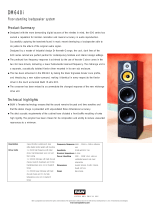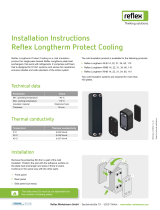APPLICATIONS
The Low Rider 18 is specifically designed
for subwoofer use, with extremely high
output capabilities and massive power
handling. It is usable to 500 Hz, although
most subwoofer applications will be
below 150 Hz.
Best performance for this driver will be
with vented enclosures between 5 and 9
cubic feet (142 to 255 liters), and vent
tunings from 30 to 45 Hz. The Low Rider
18 is optimized for vented systems but
will also work with appropriate single-
reflex bandpass enclosures. Sealed,
infinite baffle, transmission line, and dual
reflex bandpass enclosures are not
recommended.
When the Low Rider 18 is driven with a
power amplifier greater than 750 Watts,
active filtering must be included. This
filter should be a high pass 24 dB
Butterworth at a minimum of 25 Hz.
Failure to use filtering with high power
operation may cause driver damage that
could void your warranty.
The extremely high output capabilities of
the Low Rider 18 introduce the possibility
of causing structural damage to buildings,
as well as inducing permanent hearing
loss, nausea, vertigo and intestinal
disturbances in listeners. Please take
care in setting maximum sound pressure
levels.
ENCLOSURES
To assist with the growing interest in
home-built enclosure designs, Peavey
provides complete parameter data on this
driver as well as providing the user with
several recommended enclosure designs.
This information and much more can be
found at www.peavey.com.
Enclosures should be built of best-quality
3/4" to 1-1/4" (20 mm to 32 mm) marine
or other high grade plywood. If you must
use construction grade plywood, inspect
each sheet thoroughly and use grade BC
or better. Do not use plywood thinner
than 3/4". Other materials such as
particle board and MDF are not
acceptable.
Use a quality wood glue, and fit joints
tightly. Dado corner joints are highly
recommended. Use wood screws or a
pneumatic nailer to assemble the
enclosure during gluing, to maximize joint
strength.
Strength of the completed enclosure has
a great effect on the bass performance of
the finished system. Internal bracing will
be required to improve the structural
design strength of the cabinet. The Low
Rider 18 can generate enormous forces
inside the enclosure, and panels that
aren’t stiff enough will vibrate - creating
undesired sounds of their own. If your
cabinet vibrates or the cabinet panels are
not stiff enough, add more bracing.
Vents shown in the examples require
standard Schedule 40 PVC pipe for vent
construction. The pipe should be dadoed
tightly into the back of the baffle and
glued firmly in place with high quality
epoxy or high strength industrial grade
hot glue. Rough up the outside of the
pipe to improve the glue bond. Radius
the insides of the vent ends to improve
air flow and reduce vent noise.
Vents for these enclosures are much
longer than typical for an 18" subwoofer.
This reflects the special characteristics of
the Low Rider’s design that make it
possible to combine a large, high-
excursion woofer with an unusually small
enclosure. For best performance, the
inside ends of the vents should be at
least one diameter (6" / 150 mm) from
any interior wall of the enclosure. The
vent should be straight, without elbow
fittings or other methods to bend the vent
for greater length. Vent diameter should
not be decreased, as high air velocity will
result in noise and reduced power
handling.
Be sure to allow for the displacement of
the vent, bracing, and woofer in your
enclosure design before building it.
Smaller volume cabinets will reduce bass
output and mis-tune the enclosure.
Line the inside of the enclosure with
polyester fiber batting such as quilt
stuffing. The batting material should
conform to California bedding fire codes.
Attach the batting with spray adhesive or
staples, and keep material away from the
end of the vent tube where it could be
pulled in by air flow.
Handles, protective corners, cabinet
covering, grille materials and crossovers
are available through Peavey
Accessories. Take particular care in
positioning of handles as subwoofers
tend to be large and heavy.
Do not use 1/4" phone plugs and jacks in
the construction of your enclosures.
Power capacity of the Low Rider 18 is
well above safe limits for phone plugs
and jacks. Neutrik
®
Speakon
®
connectors
are highly recommended, and internal
cabinet wiring should be at least 16
gauge stranded copper wire.
Flying of subwoofers is not
recommended. An array of subwoofer
enclosures at ground level will typically
outperform any other possible
arrangement.
These instructions are a general
guideline for design. Proper construction
techniques, good planning and common
sense will result in a reliable, high quality,
high performance system.
Peavey in no way accepts liability for any
damage, accidents or injury that may
result from construction or use of
enclosures using this information.
PARAMETERS
Thiele-Small parameters for Low Rider
18" subwoofer follow. This data is for use
in designing enclosures. Numerous
software packages are available that use
this data to simulate the response of the
driver and enclosure together for
optimum performance in any application.
PARAMETER DEFINITIONS
Z
nom
: The nominal impedance of the
driver in Ohms.
R
evc
: DC resistance of the driver in
Ohms. Also known as R
e
.
S
d
: The functional radiating surface
area of the cone assembly, in meters
2
.
BL: Efficiency of the voice coil and
magnet system in Telsa meters.
F
o
: Free air resonance. Also known
as Fs.
V
as
: Volume of air having the same
compliance (springiness) as the driver’s
suspension.
C
ms
: Restorative force of the driver’s
suspension in micrometers/Newton.
M
ms
: The total mass of the moving
parts of the loudspeaker, including the air
load, in grams.
Q
ms
: Resonance characteristics of the
mechanical factors of the loudspeaker.
Q
es
: Resonance characteristics of
electrical factors of the loudspeaker.
Q
ts
: Resonance characteristics of the
electrical and mechanical factors
combined together.
X
max
: Distance the cone can move in
one direction before the coil begins to
leave the magnetic gap.
SPECIFICATIONS 1808-8HPS Low Rider 18
Part # 00479910
Size: inches / mm 18" / 460 nominal
Frame OD inches / mm 18-1/8" / 460
Bolt circle inches / mm 17-3/8" / 441
Cutout diameter inches/mm 16-3/4" / 425
Depth 6-3/8" / 162
Impedance: 8 Ohms
Power Capacity: 3200 W peak
1600 W program
800 W continuous per AES 2-1984, 50 Hz – 500 Hz
Usable frequency range: 25 Hz ~ 500 Hz
Cone: Kevlar
®
impregnated cellulose
Voice coil diameter: 100 mm
Voice coil material: Polyimide coated copper ribbon wire
Polyimide-impregnated fiberglass former
Nomex
®
stiffener
Ultrasonically welded OFHC copper leads
Net weight lb. / kg: 22 / 10
Z
nom
(Ohms) 8
R
evc
(Ohms) 6.21
S
d
(Square Meters) 0.1237
BL (T/M) 22.73
F
o
(Hz) 28.9
V
as
(liters) 403.9
C
ms
(uM/N) 185.9
M
ms
(gm) 163.2
Q
ms
8.770
Q
es
.356
Q
ts
.342
X
max
(mm) 9.6
L
e
(mH) .87
SPL (1W 1m) 97.3
n
o
(%) 2.65
V
d
cubic inches / milliliters 145 / 2375
P
max
(Watts pgm.) 1600
Disp (inches
3
) / milliliters 235 / 3852



